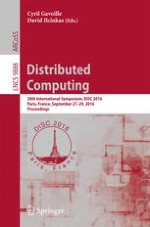2016 | Buch
Distributed Computing
30th International Symposium, DISC 2016, Paris, France, September 27-29, 2016. Proceedings
herausgegeben von: Cyril Gavoille, David Ilcinkas
Verlag: Springer Berlin Heidelberg
Buchreihe : Lecture Notes in Computer Science
